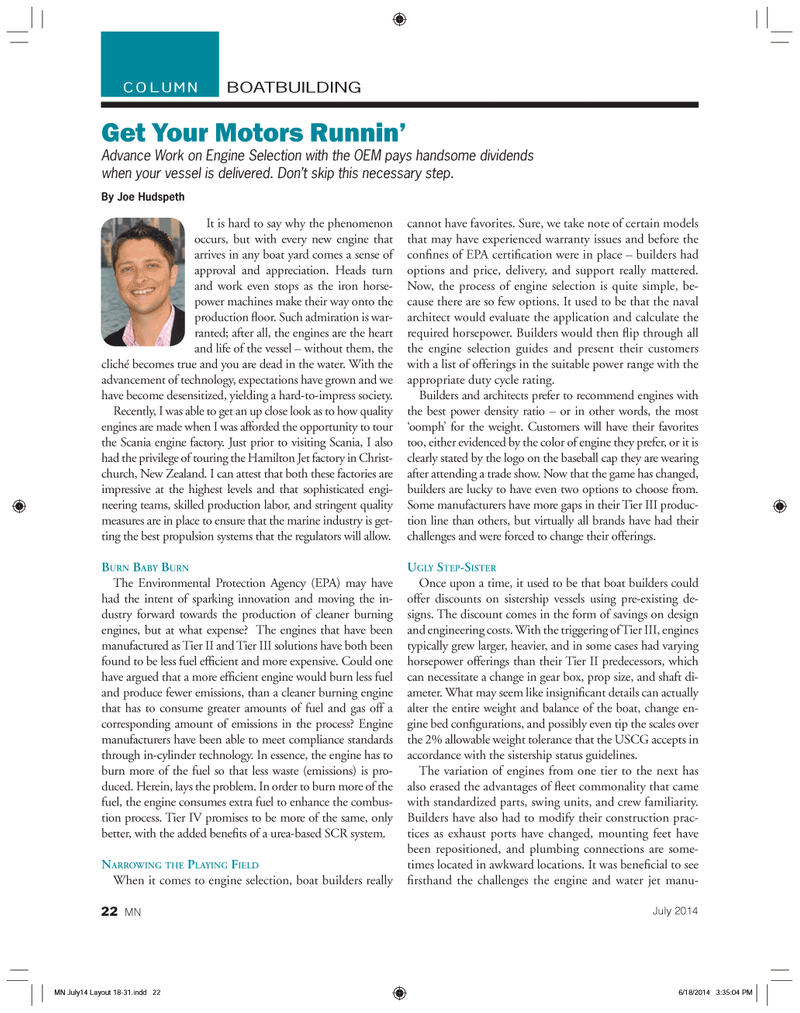
Page 22: of Marine News Magazine (July 2014)
ATB Technical Trends
Read this page in Pdf, Flash or Html5 edition of July 2014 Marine News Magazine
It is hard to say why the phenomenon occurs, but with every new engine that arrives in any boat yard comes a sense of approval and appreciation. Heads turn and work even stops as the iron horse- power machines make their way onto the production ß oor. Such admiration is war- ranted; after all, the engines are the heart and life of the vessel Ð without them, the clich? becomes true and you are dead in the water. With the advancement of technology, expectations have grown and we have become desensitized, yielding a hard-to-impress society. Recently, I was able to get an up close look as to how quality engines are made when I was afforded the opportunity to tour the Scania engine factory. Just prior to visiting Scania, I also had the privilege of touring the Hamilton Jet factory in Christ- church, New Zealand. I can attest that both these factories are impressive at the highest levels and that sophisticated engi- neering teams, skilled production labor, and stringent quality measures are in place to ensure that the marine industry is get- ting the best propulsion systems that the regulators will allow. BURN BABY BURNThe Environmental Protection Agency (EPA) may have had the intent of sparking innovation and moving the in- dustry forward towards the production of cleaner burning engines, but at what expense? The engines that have been manufactured as Tier II and Tier III solutions have both been found to be less fuel efÞ cient and more expensive. Could one have argued that a more efÞ cient engine would burn less fuel and produce fewer emissions, than a cleaner burning engine that has to consume greater amounts of fuel and gas off a corresponding amount of emissions in the process? Engine manufacturers have been able to meet compliance standards through in-cylinder technology. In essence, the engine has to burn more of the fuel so that less waste (emissions) is pro- duced. Herein, lays the problem. In order to burn more of the fuel, the engine consumes extra fuel to enhance the combus-tion process. Tier IV promises to be more of the same, only better, with the added beneÞ ts of a urea-based SCR system. NARROWING THE PLAYING FIELDWhen it comes to engine selection, boat builders really cannot have favorites. Sure, we take note of certain models that may have experienced warranty issues and before the conÞ nes of EPA certiÞ cation were in place Ð builders had options and price, delivery, and support really mattered. Now, the process of engine selection is quite simple, be- cause there are so few options. It used to be that the naval architect would evaluate the application and calculate the required horsepower. Builders would then ß ip through all the engine selection guides and present their customers with a list of offerings in the suitable power range with the appropriate duty cycle rating. Builders and architects prefer to recommend engines with the best power density ratio Ð or in other words, the most ÔoomphÕ for the weight. Customers will have their favorites too, either evidenced by the color of engine they prefer, or it is clearly stated by the logo on the baseball cap they are wearing after attending a trade show. Now that the game has changed, builders are lucky to have even two options to choose from. Some manufacturers have more gaps in their Tier III produc- tion line than others, but virtually all brands have had their challenges and were forced to change their offerings. UGLY STEP-SISTEROnce upon a time, it used to be that boat builders could offer discounts on sistership vessels using pre-existing de- signs. The discount comes in the form of savings on design and engineering costs. With the triggering of Tier III, engines typically grew larger, heavier, and in some cases had varying horsepower offerings than their Tier II predecessors, which can necessitate a change in gear box, prop size, and shaft di- ameter. What may seem like insigniÞ cant details can actually alter the entire weight and balance of the boat, change en- gine bed conÞ gurations, and possibly even tip the scales over the 2% allowable weight tolerance that the USCG accepts in accordance with the sistership status guidelines. The variation of engines from one tier to the next has also erased the advantages of ß eet commonality that came with standardized parts, swing units, and crew familiarity. Builders have also had to modify their construction prac- tices as exhaust ports have changed, mounting feet have been repositioned, and plumbing connections are some- times located in awkward locations. It was beneÞ cial to see Þ rsthand the challenges the engine and water jet manu- BOATBUILDING COLUMNGet Your Motors Runnin? Advance Work on Engine Selection with the OEM pays handsome dividends when your vessel is delivered. Don?t skip this necessary step. By Joe Hudspeth22 MNJuly 2014MN July14 Layout 18-31.indd 22MN July14 Layout 18-31.indd 226/18/2014 3:35:04 PM6/18/2014 3:35:04 PM

 21
21

 23
23
